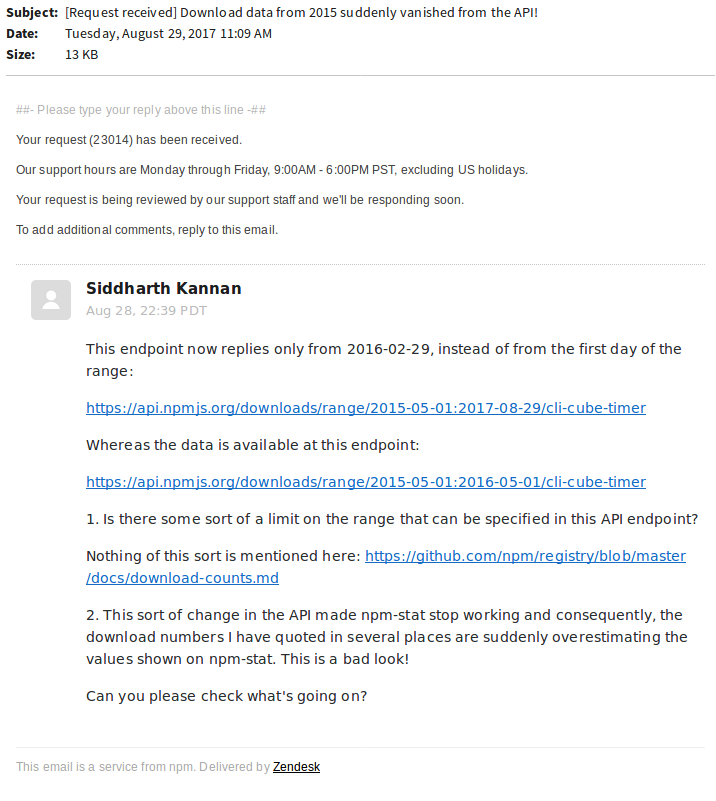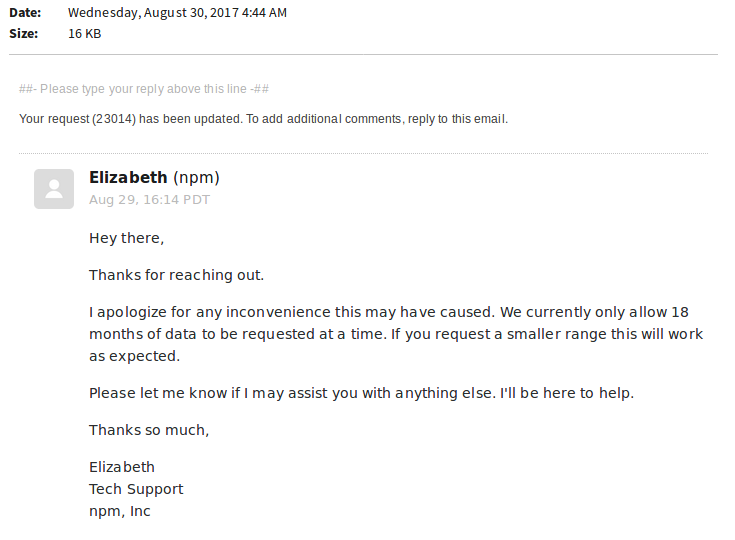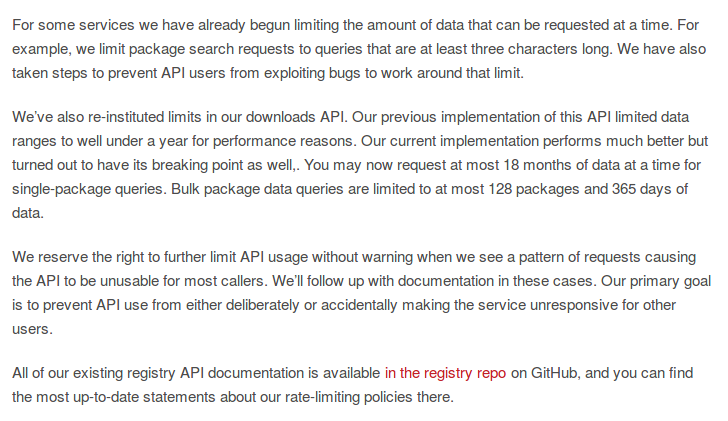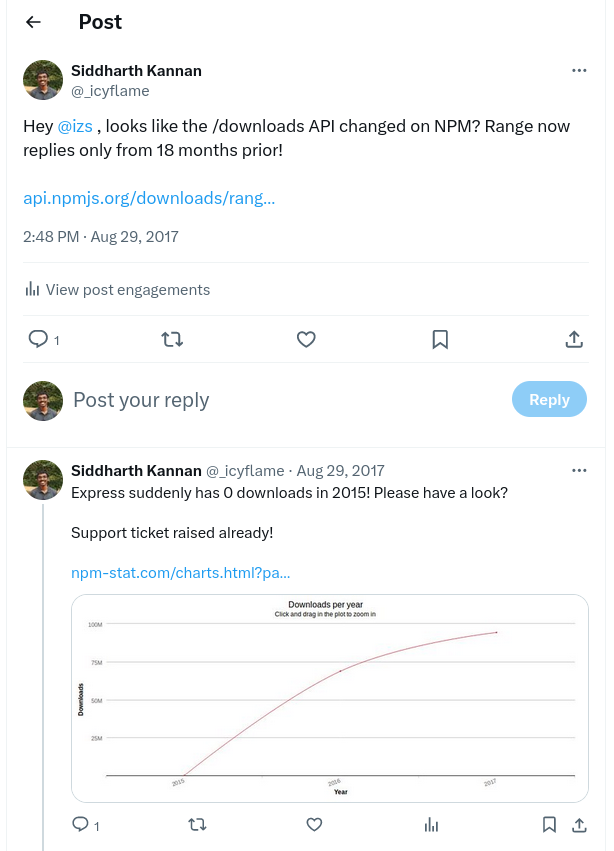NPM changes downloads-stats API and informs the world 38 hours later
08 Oct 2017 api · goofs · npm · softwareThere are two parts to this post. The first is about what happened, chronologically and the second part is about why I was so disappointed with this.
Note: All the times in this post which are not annotated are India Standard Time = GMT + 5.5
What happened?
-
Around 10 AM on 29th August, 2017, I was proof reading my resume and clicked on one of the npm-stat.com links that I have there. I reached that page and realised that the number shown there was drastically low compared to the number that I already knew was the real one.
I was surprised. The first thing that came to mind was that NPM had deleted the old data leading to the downloads in 2015 being shown as 0. I immediately checked other packages. I checked some really famous packages like
expressand users like @sindresorhus. All of their downloads were being shown as 0 in 2015. -
I dug a bit more and reached the code-base for npm-stat.com and from the line on the website “All data comes directly from NPM”, I realised that the website probably worked using an API from NPM itself.
npm-stat.com is a webpack based frontend JS app. I have some experience with them and thus, I was quickly able to figure out where the API call was happening.
It was these 3 lines:
function getDownloadsUrl(pkg, fromDate, toDate) { return '/downloads/range/' + dateToDayKey(fromDate) + ':' + dateToDayKey(toDate) + '/' + encodeURIComponent(pkg); }The request is of the form:
/downloads/range/2015-05-01:2016-11-01/terminal-wallet -
Now that I had found out the downloads API itself, I immediately checked if the data for 2015 was there or not. I found that it was. This was a relief. I immediately downloaded JSONs of everything from 2015 to that day, but this was where I noticed the rate-limiting!
I requested data from 2015-05-01 to 2017-08-29 but it only returned data starting from 2016-02-29, that’s exactly 18 months before the end date. I had found the issue!
-
This was the first real milestone. Once I realised what was going on, I immediately reached out to people:
(a) Open a ticket with NPM support

(b) Tweet to @izs
(c) Open an issue on npm/registry. Here again, the complete issue was explained.
(d) Send an email to Paul Vorbach who’s the maintainer of npm-stat.com.
-
All this was going down at 11 am IST on Tuesday 29th August 2017. That’s 10:30 PM PDT which is the timezone NPM support seems to be operating in. So, I wasn’t expecting a response from them until the next day at the least. I got an official reply on the support ticket 17 hours after at 4:44 am on 30th August 2017.

-
After all this reaching out, (it was around noon already), I sat down to work a patch for npm-stat.com. It took me about a day. Around 4 pm the next day, on August 30, I opened npm-stat.com #47.
There was one round of back-and-forth with @pvorb before the PR was merged on September 7th, a week later.
-
On August 31st 1 AM IST, 38 hours after I first noticed the problem, (I have no way to know exactly when the API was changed), they announced the rate-limiting on their blog.

The documentation on npm/registry that they are talking about was added in two commits:
chore: document downloads api limits at 2:08 AM IST on August 31st
fix: jan 10 not jan 01 at 2:24 AM IST on August 31st.
I found this from git’s blame view. Clearly, their plan was all along to make the change and inform later.
Why do I even care?
It’s just a downloads API, CHILL MAN.
No one actually said that to me, but you might be wondering why this was such a big deal for me.
Mainly because I have download numbers on my CV and when someone clicks on the link and sees a number less than the number they just saw and no apparent explanation, it’s a bad look. There’s almost no explanation that can be given in less than a few minutes time. (Hence, the request to Paul Vorbach to put a note on his website)
Also because this was unprecedented! This sort of an API change (i.e. a change without any prior warning) leads to every tool that depends on the API malfunctioning! Their official stand is that they will keep doing it in the future as well, and they will only follow-up with documentation:
We reserve the right to further limit API usage without warning when we see a pattern of requests causing the API to be unusable for most callers. We’ll follow up with documentation in these cases. Our primary goal is to prevent API use from either deliberately or accidentally making the service unresponsive for other users.
Conclusion
I like NPM. Irrespective of that, if you want to work with Node.js then you are
absolutely going to HAVE to use it. There are many things that could have been
done better here: more warning before such API changes, a tweet an hour before
the API change was deployed would have been notice enough. Or how about adding a
field to the /downloads api response that informed the user that the data is
not for the complete range that they requested because of a new API change.
They have a monthly newsletter, a Twitter account, a blog and they chose not to post about this anywhere. I can only guess that they were undergoing an attack and they had to limit the API to fight that. I can’t believe anyone would have a planned move to limit data and not inform their users about it prior to the change itself.
Explaining a change 38 hours after deploying the change is just not acceptable for an API that’s so prevalent.
TL; DR
NPM limited their /downloads API to return data only for the last
18 months if you request for a range more than 18 months. They informed the
world about it 38 hours after I first noticed the change. This lead to
npm-stat.com malfunctioning and showing drastically low numbers because of years
of data was simply not there.
